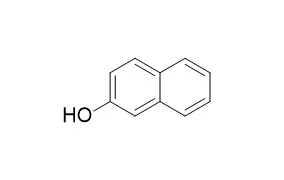| In vitro: |
| Journal of Electroanalytical Chemistry, 2001, 507(1):206-214. | | Anodic oxidation of 2-naphthol at boron-doped diamond electrodes.[Reference: WebLink] |
METHODS AND RESULTS:
The anodic oxidation of 2-Naphthol in acid media was investigated at a synthetic boron-doped diamond thin film electrode (BDD) using cyclic voltammetry and bulk electrolysis. The results have shown that in the potential region, where the supporting electrolyte is stable, reactions involving simple electron transfer, such as oxidation of 2-Naphthol to naphthoxy radical and 1,4-naphthoquinone occur. Polymeric materials, which lead to electrode fouling, are also formed in this potential region. Electrolysis at high positive potentials in the region of electrolyte decomposition causes complex oxidation reactions by electrogenerated hydroxyl radicals leading to the complete incineration of 2-Naphthol. Electrode fouling is inhibited under these conditions.
CONCLUSIONS:
The experimental results have been also compared with a theoretical model. This model is based on the assumption that the rate of the anodic oxidation of 2-Naphthol is a fast reaction and it is under diffusion control. | | Toxicology in Vitro, 2008, 22(6):1555-1561. | | In vitro toxicity of naphthalene, 1-naphthol, 2-naphthol and 1,4-naphthoquinone on human CFU-GM from female and male cord blood donors.[Reference: WebLink] | In animal models, naphthalene toxicity has been studied in different target organs and has been shown to be gender-dependent and metabolism related. In humans, it is readily absorbed and is metabolised by several cytochrome P450’s. Naphthalene and its metabolites can cross the placental barrier and consequently may affect foetal tissues.
METHODS AND RESULTS:
The aim of this study was to compare the in vitro toxicity of naphthalene and its metabolites, 1-naphthol, 2-Naphthol and 1,4-naphthoquinone, on human haematopoietic foetal progenitors (CFU-GM) derived from newborn male and female donors. The mRNA expression of Cyp1A2 and Cyp3A4 was also evaluated.
Naphthalene did not affect CFU-GM proliferation, while 1-naphthol, 2-Naphthol and particularly 1,4-naphthoquinone strongly inhibited the clonogenicity of progenitors, from both male and female donors. mRNA of Cyp1A2 and Cyp3A4 was not expressed neither at the basal level, nor after naphthalene treatment, while treatment with 1,4-naphthoquinone induced expression of both enzymes in both genders, with Cyp1A2 being expressed four times more than Cyp3A4. Female CFU-GM was significantly more sensitive to 1,4-naphthoquinone than male and after treatment both enzymes were expressed twice as much as in the male precursors.
CONCLUSIONS:
These results suggest that a gender-specific 1,4-naphthoquinone metabolic pathway may exist, which gives rise to unknown toxic metabolites. | | Journal of Hazardous Materials, 2009, 166(1):33-38. | | Synergistic degradation of 2-naphthol by Fusarium proliferatum and Bacillus subtilis in wastewater.[Pubmed: 19070430] | 2-Naphthol, which originates widely from various industrial activities, is toxic and thus harmful to human liver and kidney.
METHODS AND RESULTS:
A new compound biodegradation system was adopted to degrade 2-Naphthol-contaminated wastewater. Enzymatic response to 2-Naphthol biodegradation in the aqueous phase was also studied. As a co-metabolic substrate, salicylic acid could induce the two microorganisms to produce a large amount of degradation enzymes for 2-Naphthol. The key enzymes were confirmed as polyphenol oxidase (PPO) and catechol 2,3-dioxygenase (C23O). The degradation extent of 2-Naphthol, determined by high performance liquid chromatography (HPLC), was enhanced by nearly 15% on the 6th day after the addition of the co-metabolic substrate.
CONCLUSIONS:
The results obtained thus clearly indicated that the co-metabolic process was the most important factor affecting the degradation of the target contaminant. The optimal concentration of 2-Naphthol was 150 mg L(-1), and the optimal pH value was 7.0. The degradation extent of 2-Naphthol was further enhanced by nearly 10% after the addition of Tween 80, which increased the bioavailability of 2-Naphthol. In a practical treatment of industrial wastewater from medical manufacture, the synergistic degradation system resulted in a high degradation efficiency of 2-Naphthol although its lag time was a little long in the initial stage. | | Appl Microbiol Biotechnol,2012 Aug;95(3):789-98. | | Biodegradation of polycyclic aromatic hydrocarbons by a halophilic microbial consortium.[Pubmed: 22086071] |
METHODS AND RESULTS:
In this study we investigated the phenanthrene degradation by a halophilic consortium obtained from a saline soil sample. This consortium, named Qphe, could efficiently utilize phenanthrene in a wide range of NaCl concentrations, from 1% to 17% (w/v). Since none of the purified isolates could degrade phenanthrene, serial dilutions were performed and resulted in a simple polycyclic aromatic hydrocarbon (PAH)-degrading culture named Qphe-SubIV which was shown to contain one culturable Halomonas strain and one unculturable strain belonging to the genus Marinobacter. Qphe-SubIV was shown to grow on phenanthrene at salinities as high as 15% NaCl (w/v) and similarly to Qphe, at the optimal NaCl concentration of 5% (w/v), could degrade more than 90% of the amended phenanthrene in 6 days. The comparison of the substrate range of the two consortiums showed that the simplified culture had lost the ability to degrade chrysene but still could grow on other polyaromatic substrates utilized by Qphe. Metabolite analysis by HPLC and GC-MS showed that 2-hydroxy 1-naphthoic acid and 2-Naphthol were among the major metabolites accumulated in the Qphe-SubIV culture media, indicating that an initial dioxygenation step might proceed at C1 and C2 positions.
CONCLUSIONS:
By investigating the growth ability on various substrates along with the detection of catechol dioxygenase gene, it was postulated that the uncultured Marinobacter strain had the central role in phenanthrene degradation and the Halomonas strain played an auxiliary role in the culture by utilizing phenanthrene metabolites whose accumulation in the media could be toxic. |
|






 Cell. 2018 Jan 11;172(1-2):249-261.e12. doi: 10.1016/j.cell.2017.12.019.IF=36.216(2019)
Cell. 2018 Jan 11;172(1-2):249-261.e12. doi: 10.1016/j.cell.2017.12.019.IF=36.216(2019) Cell Metab. 2020 Mar 3;31(3):534-548.e5. doi: 10.1016/j.cmet.2020.01.002.IF=22.415(2019)
Cell Metab. 2020 Mar 3;31(3):534-548.e5. doi: 10.1016/j.cmet.2020.01.002.IF=22.415(2019) Mol Cell. 2017 Nov 16;68(4):673-685.e6. doi: 10.1016/j.molcel.2017.10.022.IF=14.548(2019)
Mol Cell. 2017 Nov 16;68(4):673-685.e6. doi: 10.1016/j.molcel.2017.10.022.IF=14.548(2019)